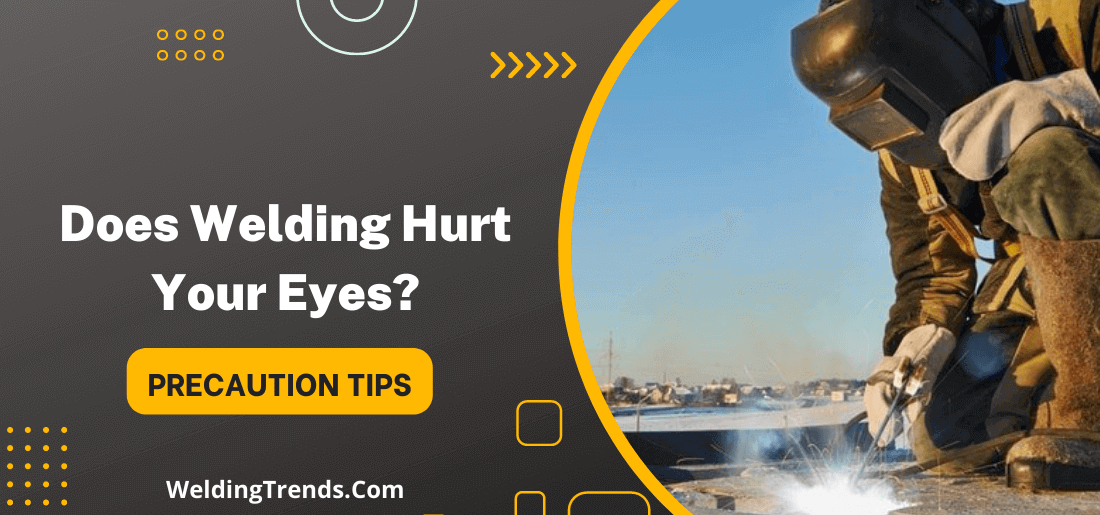Welding is a process that uses intense heat to join two pieces of metal together. While it can be a very useful process, it can also be dangerous if not done correctly.
Welders have to be careful with their eyes. We all know that welding can be dangerous but did you know that it can also be bad for your eyes?
In this blog post, we’ll take a look at some of the risks associated with welding and how to stay safe. We’ll also discuss some of the steps that welders can take to protect their vision. So, is welding bad for your eyes? Let’s find out!
Is Welding Bad For Your Eyes?
The short answer is yes, welding can be bad for your eyes if proper safety measures are not taken. The intense light and heat from the welding process can cause a condition called arc eye, or photokeratitis. This is when the UV rays from the weld burn the surface of the cornea, leading to temporary vision loss and extreme discomfort.
But it’s not just the UV rays that can harm a welder’s eyes. The intense heat and flying sparks can lead to burns or damage to the eye and welders may also be at risk of inhaling dangerous fumes.
Also, welders may be at risk for more long-term damage to their eyes, such as cataracts or macular degeneration.
Risks associated with welding including eye damage
Following are the risk associated with welding include:
1) Burns and electric shock
While welding, the intense heat from the equipment can cause burns to the skin. In addition, electric shock can occur if proper safety measures are not taken.
2) Eye damage
The bright light and UV rays generated during welding can cause damage to the eyes, including permanent blindness in severe cases. It is important to always wear a welding helmet with an appropriate lens shade.
3) Fumes and gases
Breathing in welding fumes and gases can lead to respiratory issues and long-term health problems. It is important to have proper ventilation in the workspace, as well as to wear a respirator if needed.
4) Fire and explosions
The intense heat from welding equipment can easily start a fire, especially when working with flammable materials. In addition, explosions can occur if combustible gases are not properly cleared from the workspace.
5) Noise pollution
Welding can be a noisy process and prolonged exposure to loud noise can lead to hearing loss. It is important to wear ear protection while welding.
6) Repetitive strain injuries
Repeatedly using the welding equipment can lead to strain and injury in the wrists, arms and shoulders. Taking frequent breaks and using proper techniques can help prevent these types of injuries.
7) Slips, trips and falls
The workspace should be kept clear of any potential hazards that could cause someone to trip or slip. In addition, wearing appropriate footwear can help prevent falls.
Overall, it is important to always prioritize safety while welding and follow all necessary precautions to avoid these risks.
How to protect your eyes while welding?
There are some steps that welders can take to protect their eyes while welding.
- First, always wear a proper welding helmet with an appropriate lens shade. This will help safeguard against the intense light and UV rays generated during the welding process.
- Second, wear protective goggles or eyewear to guard against any flying sparks or debris.
- Third, make sure to take breaks and look away from the welding area periodically to give your eyes a rest from the intense light.
- Lastly, always have a first aid kit available in case of an eye injury and seek immediate medical attention if needed.
By following these precautions, welders can greatly reduce the risk of harm to their eyes while welding.
Treatment for welding-related eye injuries
Treatment for welding-related eye injuries can vary depending on the specific injury. For arc eye or photokeratitis, treatment typically involves pain medication and using lubricating eye drops to soothe the affected area.
In more severe cases of burns or damage to the eyes, surgery may be necessary. It is important to seek immediate medical attention for any eye injuries while welding.
Preventative measures, such as wearing proper protective gear and taking breaks, can greatly reduce the risk of eye injuries while welding.
The best treatment for welding-related eye injuries is prevention. Wearing appropriate protective gear and following safety guidelines can help protect the eyes while welding. In the event of an injury, seeking immediate medical attention is crucial to minimize any long-term damage. Taking these precautions can help ensure the safety and well-being of welders.
Prevention is better than cure – Follow the safety precautions when welding to avoid any accidents
Yes, prevention is indeed better than cure. In the case of welding, it’s important to always follow safety precautions such as wearing protective gear, keeping a fire extinguisher nearby and making sure your work area is clear of flammable materials.
By taking these measures, you can prevent any accidents from happening. Don’t let carelessness ruin your project or worse, harm yourself or those around you. Safety should always come first in welding.
So remember, always follow the necessary safety precautions when welding to ensure a successful and accident-free project. Another important aspect of welding safety is making sure your equipment is in good working condition.
Every year research tells us that, faulty equipment is one of the leading causes of accidents in welding. So, regularly check and maintain your equipment to prevent any malfunctions or accidents while on the job.
In the end, taking all safety precautions and properly maintaining your equipment can save you from potentially harmful situations. Prevention is key in welding, so always prioritize safety before beginning any project.
FAQs – can welding hurt your eyes
How long does it take for welding to damage your eyes?
There is no set timeline for how long it may take for welding to damage your eyes. It can vary depending on the intensity and duration of exposure to the intense light and UV rays generated during welding, as well as any protective measures taken while welding.
Do welders need good eyesight?
Having good eyesight can be helpful as a welder, but it is not necessarily a requirement. Many welders utilize magnifying lenses or other assistive devices to compensate for any vision impairments.
Can the cornea repair itself?
In some cases, the cornea may be able to repair itself with proper medical treatment. However, severe damage to the cornea may require surgery to correct it. Because of this, it is important to seek immediate medical attention for any eye injuries while welding.
What is a safe distance to watch welding?
It is recommended to stay at least 10 feet away from the welding area to avoid any potential harm from the intense light and heat generated during the process.
Wearing proper eye protection, such as a face shield, can also help protect against any potential hazards while watching welding.
Conclusion
Welders have long been concerned about the potential for eye damage from welding. While there is some risk, it’s important to remember that welders can take steps to protect their vision and stay safe on the job.
In this article, we’ve looked at the risks welders face and how they can minimize those risks. We hope you found this information helpful and feel more confident in your ability to weld safely!




